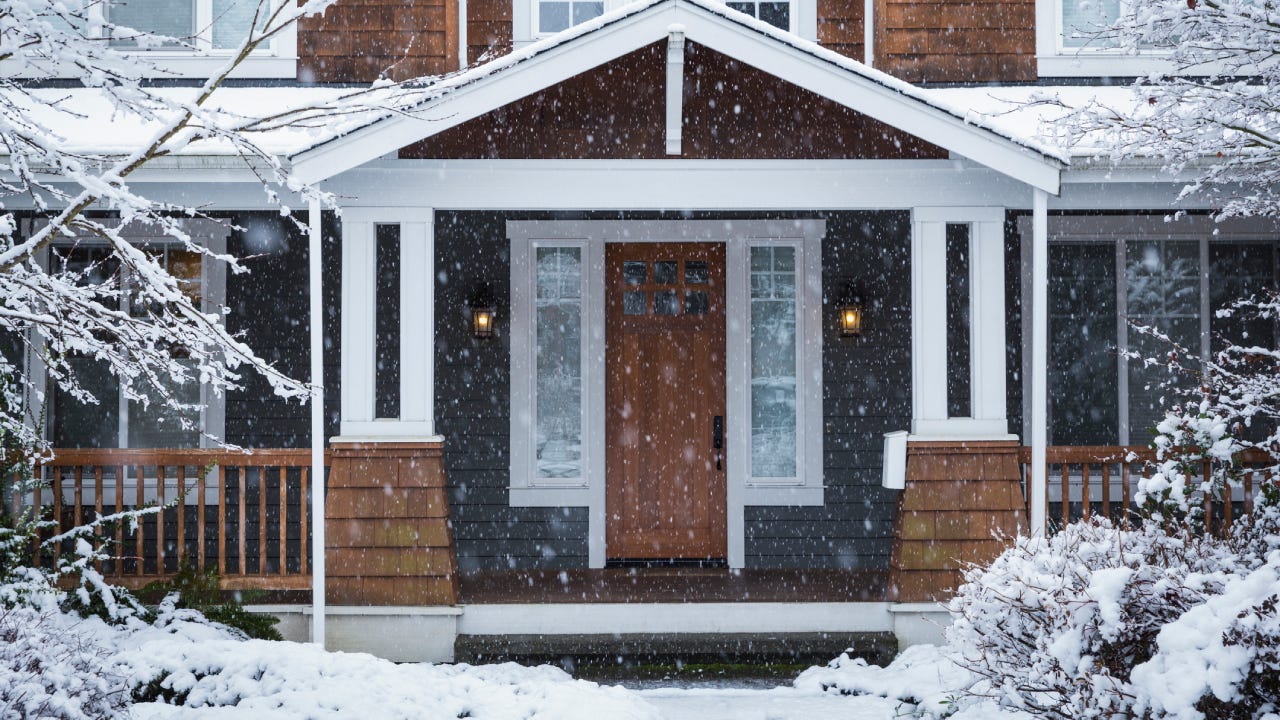12 Steps to prepare your home for winter

Extreme weather events have been on the rise, but not everyone has taken steps to prepare for it. Bankrate’s Extreme Weather Survey found that 2 in 5 homeowners have not done anything in the past five years to protect their property against the kind of damage an extreme weather event can cause. Getting your home ready for winter weather doesn’t always need to be a massive undertaking. Bankrate’s insurance experts have put together this guide on how to prepare your house for winter to help avoid a costly insurance claim.
- 1 in 4 U.S. homeowners say they are unprepared for the financial cost of extreme weather. (Bankrate Extreme Weather Survey)
- The average cost of owning and maintaining a single-family home in the U.S. is more than $18,000 per year, up more than 25% compared to four years ago. (Bankrate Hidden Costs of Homeownership Survey)
- In 2023, winter storms caused an estimated $3.4 billion in insured losses. (Insurance Information Institute)
How to prepare your home’s exterior for winter
Your home’s exterior is the first line of defense against harsh winter weather. Your winterizing needs will vary depending on your home type and where you live, but here are some basic winter tips for homeowners — ranging from tasks you can knock out in an afternoon to more elaborate projects.
Clean your gutters
It sounds simple, but cleaning your gutters before winter is crucial. It can help prevent leaves and debris from causing blockages, which can slow down water drainage, increase the likelihood of ice dams, and put extra strain on your gutters and roof. To do it yourself, start by securing your ladder with the help of a partner. Clear out the debris using gloved hands or a scoop, check for leaks and cracks and ensure gutters are firmly secured to your house. Lastly, run water through the downspouts to identify and clear any blockages. If you encounter stubborn clogs or safety issues, you may want to consider hiring professional help.
Cost of professional gutter cleaning: $119 to $234
Trim back tree branches
Winter snow and wind put a strain on trees, and even healthy branches can be at risk of breaking under the weight. Trimming back branches that overhang your home can help you avoid roof damage from falling branches. For trees, it’s best to prune during late winter or early spring when most plants are dormant. This timing makes it easier for plants to recover and energizes them to produce new growth with the arrival of spring. Experts recommend researching proper techniques to ensure clean cuts and avoid removing more than a third of the tree at once to prevent undue stress. Or, if you’re unsure about how to do it, you can always hire a professional.
Cost of professional tree trimming: $270 to $1,800
Re-caulk your windows
Re-caulking windows helps prevent air and water infiltration. It can also help to retain heat, which could help lower your winter heating bill. and retains heat inside your home. If you’re doing it yourself, use silicone-based sealants.
Cost of professional window caulking: $50 to $70 per window
Get your roof inspected
Most insurance and home maintenance experts recommend inspecting your roof once a year. Getting your roof inspected before winter is essential for several reasons. It prepares your roof for harsh winter conditions and helps prevent further snow damage by identifying potential problems early on. An inspection can reveal issues caused by weathering during the spring and summer, allowing you to winterize your roof and avoid new damage or water intrusion. Additionally, a well-maintained roof can contribute to lower winter bills by keeping your home better insulated against the cold.
Cost of professional roof inspection: $125 to $357
Get your chimney inspected
A chimney inspection should cover several areas, including inspecting the chimney cap for damage, checking the flashing where it meets the roof to prevent water entry, repairing the chimney exterior, cleaning the flue, removing leftover ash from previous fires, and testing the damper for proper opening and closing. This proactive approach keeps your home safe and ensures a cozy and warm winter. Be sure to hire a licensed chimney sweep to ensure a thorough, accurate inspection.
Cost of professional chimney inspection: $450 on average
How can you prepare your home’s interior for winter?
Now that we have covered the exterior, let’s move to the inside of your home. Here are some steps you can take to make sure your home’s interior is ready for winter.
Inspect your home’s systems
Before winter arrives, have HVAC systems inspected to ensure they heat your home evenly without drafts. Visually inspect electrical systems without touching them to spot wear or damage. It is safer to hire a professional inspector if you are unsure about performing these checks safely. Additionally, if you have carbon monoxide detectors, change the batteries and perform a test if your model allows you to do that. Carbon monoxide is odorless, colorless and incredibly dangerous, so a functioning detector is key to helping ensure winter safety. According to Johns Hopkins Medicine, most carbon monoxide leaks occur during the winter months.
Cost of professional HVAC inspection: $300 on average
Reverse your ceiling fans
Preparing your home for winter can be as easy as flipping a switch. Reversing your ceiling fans to rotate clockwise during winter can be a simple yet effective way to save on your heating costs. This change creates an updraft that circulates warm air near the ceiling down into the living space, helping to distribute heat more evenly. This improved circulation allows you to set your thermostat at a lower temperature while still feeling warm.
Enhance your home’s insulation
Enhancing your home insulation for winter will help keep your home warm and cozy. If you use a screen door to cool off your house in the summer, replace the screen on your storm door with a glass pane to prevent drafts. You don’t have to be a homeowner to find ways to better insulate your home and save money on utilities. You can seal drafty doorways with weatherstripping and use double draft stoppers for larger gaps. Add a layer of protection to drafty windows using plastic sheeting and hang thick curtains with thermal backing to keep cold out — all cheap and temporary options that work for anyone.For homeowners who want to take extra insulation measures, you can insulate exterior foundation walls, seal exterior holes with pest-resistant foam, insulate rim joists with rigid insulation, and caulk and cover room air conditioners.
Cost of professional weatherstripping installation: $131 to $433
Protect your plumbing
To protect your plumbing from freezing temperatures in winter, it’s crucial to insulate pipes in your home’s crawl spaces, attic and garage. Use pipe insulation, heat tape or thermostatically controlled heat cables, and seal leaks that allow cold air inside, especially if the leak is located near pipes.If you experience freezing weather where you live and you do not plan on using your hose bib this winter (the faucet on the exterior of your home), disconnect the garden hose, and shut off and drain the water. During cold snaps, prevent freezing pipes by letting warm water drip from your faucet overnight, open cabinet doors to allow heat to reach uninsulated pipes and keep your thermostat set at 60 degrees or warmer. These steps can prevent your pipes from freezing and bursting.
Cost of professional pipe insulation: $1.10 to $11 per square linear foot
Flush your boiler
A functioning boiler can help keep your home warm during the cold winter months. To make sure it’s working properly, most experts suggest flushing and draining it every six to twelve months to help prevent sediment buildup. To do it yourself, first turn the system off and locate the drain valve. Then, attach a garden hose to the drain valve and open the drain valve. Flush the system a couple of gallons at a time, then refill and check for leaks. Like with any DIY project, if you’re not feeling confident tackling it alone, you can always consult a professional.
Cost of professional boiler flush: $75 to $200
How to prepare your garden and tools for winter
Don’t neglect your yard, garden and tools as the temperatures drop. Make sure to clean dirt and debris from your garden tools, allow them to fully dry and then rub metal tools with mineral oil before storing them away for the winter to prevent rusting. These winter home tips can help keep your yard, garden and tools ready for cooler weather.
Mulch your leaves
Mulching your leaves can provide a natural source of nutrients back to the soil as the leaves decompose, which can improve soil health and fertility. Mulching leaves also saves time and effort compared to raking, as it can be done quickly with a lawn mower. In addition, it helps to protect the lawn by preventing suffocation and die-off of grass under accumulated leaves. For those with gardens, mulched leaves can be used as a protective layer for garden beds or around winter-tender plants.
Drain the fuel from your small gas-powered engines
To avoid having your lawn mower and other small gas-powered tools fail to start or require intensive cleaning in the spring, properly drain the fuel before winter storage. For two-stroke engines, empty the fuel tank by running the engine dry or pouring the gas into a gas can. Mix a proper gas-to-oil ratio, add fuel stabilizer, shake the mixture and run the engine until it stops. Pull the starter cord a few times to burn off the remaining fuel. Remove the spark plug, lubricate the cylinder with motor oil and reinstall the spark plug.
For four-stroke engines, empty the tank, add gasoline and fuel stabilizer, run the engine to circulate the stabilizer, and drain the carburetor’s fuel bowl if possible. Always consult your owner’s manual for specific instructions for your equipment. Store the equipment in a dry, protected space.
Review your homeowners insurance policy for coverage gaps
The period right before winter is usually a good time to talk to your home insurance company to review your coverage. If you have done renovations recently that could add value to your home, make sure the added value is covered by your policy in case anything happens during the season. You may also want to confirm how your policy would cover potential winter damage, like ice dams, fires or damage from tree branches. Each type of home insurance covers different losses. Understanding how your policy would potentially cover damage before it happens could help you spot potential gaps in coverage.
Taking the time to prepare your home for winter could help you reduce the amount of damage your home sustains from winter storms or even help you avoid damage completely. Once you’ve winterized your home, you’ll hopefully feel more ready to weather the winter months.
Frequently asked questions
You may also like

When does homeowners insurance cover animal damage?


How to protect your home from wildfire



